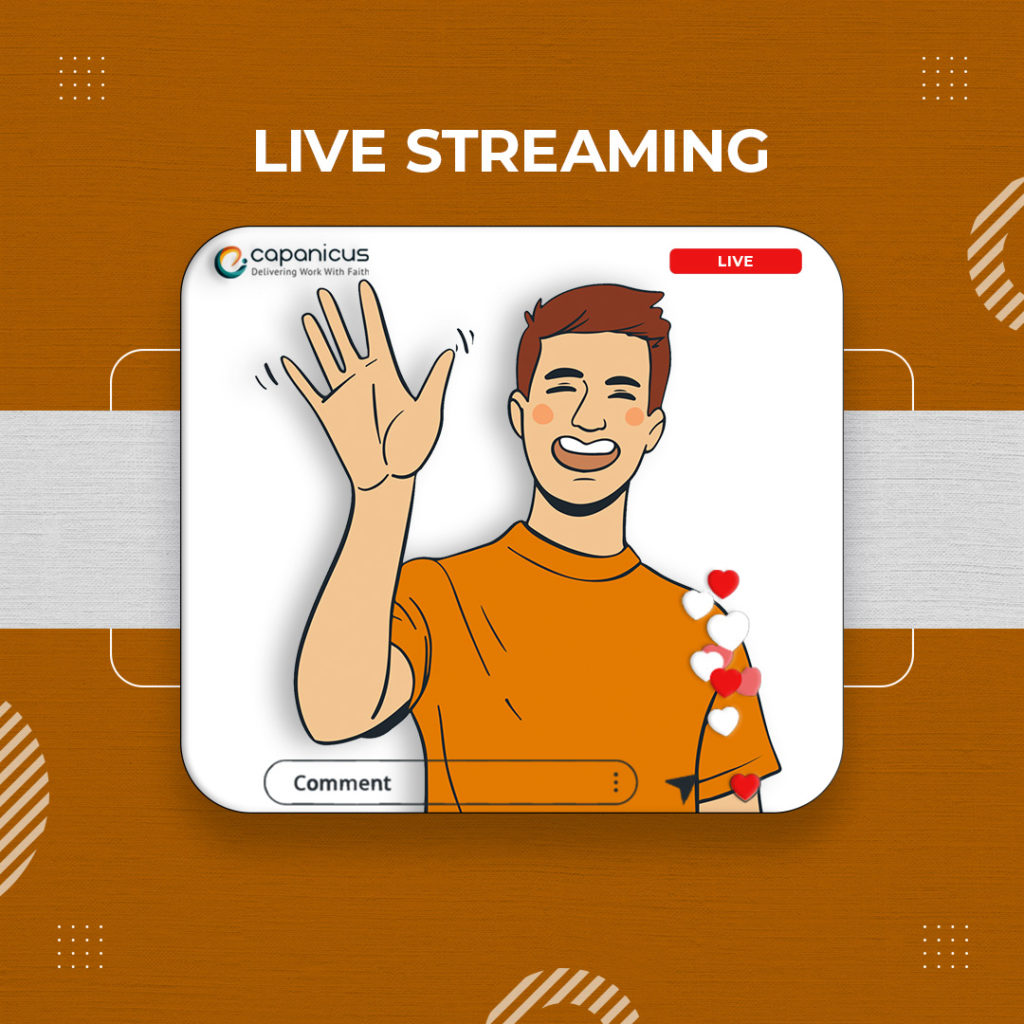
Live streaming has taken over the world in today’s industry. Video streaming is an app that allows the user to continuously record and transmit video. Due to the high internet and advanced camera technologies, the number of live video streaming apps has increased in recent years.
Live streaming is a real-time broadcast of events taking place anywhere that piques your interest, which can be viewed on computers, tablets, smartphones, game consoles, or smart TVs. It allows millions of viewers to watch and follow their favorite performance acts in real-time.
We can say that now, video streaming is a developed industry with ever-expanding boundaries. The live-streaming video platform is, without a doubt, the next big thing in the web market. The video streaming application makes a direct effect on small marketers and small businesses.
The streaming application is all about being online, the epidemic only benefited this industry. Almost every industry was looking for rapid solutions to adapt to the present scenario to stay ahead in their business and achieve the desired results.
If we talk about live streaming video applications three things are common audio, video, and broadcasting features. Influencer marketing, entertainment, corporate marketing, and the way people connect on the internet have all benefited from Video Streaming Application Development.
Live-streaming apps are in high demand across a variety of industries, including education, healthcare, marketing, and retail. Although they will be used for the same objectives, the live-streaming software can be a great match for all sectors.
We all know that whether it’s news stories, political events, comedies, cultural shows, sports games, video gamers, and top players match people like to watch on live streaming applications. Video gamers are the most frequent users of this technology.
What is a Live Streaming Platform?
A live streaming platform is an online service that allows you to broadcast and publish video content in real time rather than after it has been captured and uploaded.
According to researchers, live broadcasts have become a popular media format for a variety of reasons. Live programming engages viewers because it helps them to form a bond with the streamer and gives them a sense of social presence.
The popularity of live streaming has expanded the number of websites and mobile apps where you can post your live content.
Do you know the difference between normal streaming and live streaming in terms of an actor presenting a rehearsed monologue versus improvising a speech? The term “live streaming” refers to video that is delivered in real-time over the internet rather than being captured and preserved first.
Why is Video Streaming application so popular?
The main reason behind video streaming’s popularity is nobody wants to be bound by a television schedule, and with a video stream application, you may watch your shows whenever you want. this allows you to watch shows while traveling a train, waiting for a bus, or taking a break at work.
The Streaming application is convenient and scalable to use resulting in a personalized menu of content recommendations according to the consumer’s preferences.
Why need to go with a live video streaming application?
Live video streaming provides unbeatable digital engagement, also making it easier to send your message to the right individuals. You can create unique apps by including live streaming, video on demand, over-the-top video solutions, eCommerce-related videos, and interactive content in this application.
During the pandemic last year, people all around the world became accustomed to quarantine restrictions in almost every location. As you may be aware, individuals were limited to their houses, and businesses in a variety of industries were obliged to look for ways to become digital as rapidly as possible.
That is the primary reason why live streaming traffic increased dramatically during the period when most people were stranded at home throughout the world.
In all places, whether it is events, whether, for the entertainment industry or otherwise, conferences and other gatherings continue to be exclusively feasible online via live-streaming technologies, allowing for real-time participation.
Real-time experience with the streaming application:
Long before the Covid-19 outbreak, live broadcast events like online conferences, workshops, courses, and so on – were in high demand in educational institutions. Due to pandemic limitations, all educational facilities were forced to move their classes, seminars, quizzes, and exams online.
Live-streaming apps are the ideal answer for allowing students and teachers from schools and colleges to help to communicate in real-time, as well as for ongoing staff training.
When it comes to digital change, the healthcare business has experienced it more than any other since the coronavirus pandemic began. Other facilities held with healthcare organizations went online, in addition to online medical conferences and webinars.
This application has proved to be beneficial for the healthcare industry. Remote patient monitoring, virtual doctor engagement, and the usage of healthcare robots are all examples of ways to reduce the need for people to interact physically in hospital settings. Overall, the healthcare industry was able to adjust to changing internment procedures.
Live streaming is also thought to be effective marketing, and its popularity is growing on Social media. To attract more customers and promote their brand values, most global brands are concentrating on developing distinctive, qualified, and engaging video content.
Live video streaming has a participation impact, which means that the target audience feels like they are a part of the brand and can help it grow through the network effect.
Promoting learning with a streaming app:
This video application assists learners with education and training by allowing them to learn on their time and in their way. While live streaming of events like lectures can only reach a limited audience, a recorded lecture available on a streaming application can reach a much larger audience over a longer period.
A streaming application has several advantages, including the ability to view as many videos as you like, satisfying the number of users who can watch videos at the same time, and streaming videos at high resolution and without stuttering.
In recent years, more and more online activity has switched to mobile devices. Today, most people spend more time watching web videos than watching TV, thus it is no longer the primary source of visual content. Although some people enjoy listening to music, others choose to watch instructional or work-related content via live streaming.
Live Video streaming application feature:
Some characteristics of a Live streaming application are here sign-up- options, user profile, online streaming, chat, video sharing, storage, privacy, notification, and search features.
1. Ability to Embed Video content
Embedded video content is a functionality that is almost generally required for any video platform. Every type of organization or brand needs the ability to submit video content to its website. Because the capacity to embed video content is dependent on the service provider, it is vital to know ahead of time whether or not the service provider has this capability.
2. Ability to share on Social media Platform
Nowadays, the bulk of people is found on social media networks. Using social media to attract and engage big groups of people eventually leads to a conversation between the followers and the company. This feature allows posting content straight to the Facebook feed with some of the service providers.
3. API for integration
This feature allows customers of enterprise video platforms to create custom applications and connectors for more efficient operations. APIs offer a variety of benefits, including the opportunity to personalize video platforms, create apps with on-demand video content, and more. When selecting a business video streaming platform, keep in mind that a full-featured API is advantageous because it facilitates integration.
4. White Labelling of Video Content
The video player must be white-label because it will be used on the company’s website. The presence of a third-party logo on the featured video does not create a favorable impression. Many video service companies are known to offer this service. They enable the installation of a personalized watermark, as well as color schemes and other options.
Your online video platform should make your job easier in today’s digital environment. Today, there are a variety of live-streaming systems accessible that offer both basic and premium services.
Conclusion
Every day, the world of live broadcasting expands. Because not everyone has the opportunity to attend, more people are turning to the internet for their favorite events.
Furthermore, if you create your software, streaming can be used not just as a marketing tool but also as a standalone business. By choosing the right topic and monetization methods, you can have a lot of success.
The future of video streaming apps, led by OTT platforms, has altered audience perceptions. A live video streaming app allows several individuals to simultaneously attach information.
As a result, it will assist you in expanding your audience, initiating interactions, and cross-promoting your business across other platforms.
Hopefully, the above guide will be helpful for you to know more about the use of video streaming application platforms for any work preference.









